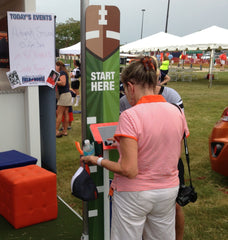 Smart marketers know that offline marketing techniques like events, conferences, and billboards are extremely powerful tactics for reaching customers. The problem? They can’t prove it.
Smart marketers know that offline marketing techniques like events, conferences, and billboards are extremely powerful tactics for reaching customers. The problem? They can’t prove it.When allocating budget towards a ‘branding’ initiative, marketers will frequently take a leap of faith. It’s common sense that businesses need to be where their customers are — especially at major trade shows and industry events — but we’d rather prioritize hard numbers over intuition.
The fact is that online marketing has spoiled us. At any given moment, we have access to a wealth of analytics tools. It takes five minutes to install Google Analytics and set up conversion tracking. Using UTM tracking codes, we can attribute every user engagement activity to a specific marketing channel or traffic source.
Offline events, on the other hand? Not so much.
Still, offline marketing is crucial for reaching customers. Major consumer brands have relied on print media and word-of-mouth marketing for more than a century. In fact, as of 2012, 82% of global ad spend was still offline. That trend is only slowly changing – digital was only 20% of global ad spend in 2013.
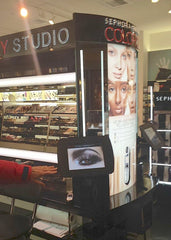 The fact is that online and offline marketing aren’t disparate. They’re interconnected. The distinction between digital and brick and mortar is nothing more than a line in the sand. Eventually the smartest marketers will learn to blend online and offline channels, treating the two channels as variants of the same customer acquisition engine.
The fact is that online and offline marketing aren’t disparate. They’re interconnected. The distinction between digital and brick and mortar is nothing more than a line in the sand. Eventually the smartest marketers will learn to blend online and offline channels, treating the two channels as variants of the same customer acquisition engine.One E-consultancy study from 2010 reports that offline channels boost online channels by 40%. Not to mention, the internet is still relatively new for some demographics (think: older adults who didn’t grow up with digital media). But still, marketers have evolved past the ‘data-blind’ days of billboards, direct mail, flyers, brochures, sales, letters, and cold calls – there are some incredibly straightforward tactics for measuring the efficacy of these offline channels. You just need two things:
(1) Tools
(2) Creativity
Over the next 3,000 words, we’re going to show you why mobile technology (iPad kiosks) are the solution to #1. We’re also going to teach you some tactics to make the most of #2. The key is to build systems that give your marketing structure. Analytics, marketing campaign attribution, and tracking should be top of mind – not an afterthought. So let’s get to it.
I. QUANTIFY WORD OF MOUTH
One goal of all marketing – online and offline – is to amplify word of mouth. This concept (which we’ll abbreviate as WOM)is a powerful marketing force. When people love your brand, they talk about it – online and offline. Thanks to social media, you can capture everything that happens in the digital world. Offline? Not so much.
 McKinsey Quarterly points out that WOM generates more than twice the sales of paid advertising in categories as diverse as skincare and mobile phones. In other words, you need to make a consistent effort to make your customers (and prospects) really, really happy. You need to wow them with a superb experience.
McKinsey Quarterly points out that WOM generates more than twice the sales of paid advertising in categories as diverse as skincare and mobile phones. In other words, you need to make a consistent effort to make your customers (and prospects) really, really happy. You need to wow them with a superb experience.Word of mouth is about the connection you build with your end users psychologically, functionally, personally, and emotionally – and it’s quantifiable. In addition to measuring whether people are talking about your brand, you can also capture sentiment (i.e. how they are talking about your brand and what they are feeling). The process shouldn’t feel like a black box. Rely on the following tactics:
1. Set up a Quick Customer Feedback Study at Your Event
Whether you’re hosting a class, speech, seminar, or conference, you can use iPad kiosks to set up quick, easy, and efficient customer feedback centers.
Not a survey methodology expert? No problem.
You don’t need to design your own survey. In fact, there are apps that can help you choose the right questions, organize results, visualize trends, and export data. TabbleDabble is one company that is building a survey tool for mobile devices.
2. Measure Direct Traffic to Your Domain
This type of web traffic is called ‘type-in’ data. When people visit your website directly, it’s a sign that you’ve become memorable – presumably, as a result of your various branding initiatives.
Look for trends over time, and look for traffic spikes that correlate with campaigns that your company has run offline. For instance, if you recently hosted an event and asked attendees to check out your website, you can monitor type-in traffic in the following days.
You can use charts and graphs to visualize correlations between marketing activities and dips/spikes in traffic. If you’re a stats nerd, you can calculate something called a Pearson Correlation Coefficient to look for relationships web traffic, foot traffic, and offline marketing spend.
Here’s a tip for you. If you’re hosting an event, and you want people to visit your website, you’ll need them to take action immediately. You can set-up iPad kiosks in high-foot traffic areas so that people can visit your website during brain-breaks. In that case, you’ll want to monitor dips and spikes in traffic during the event as well as before and after.

3. Create Memorable Coupon Codes
This tactic is especially useful for e-commerce companies (or anybody who sells a productized online service).
If you’re running any offline marketing campaigns, you can incorporate coupon codes that are dead-easy for people to remember. You can even change-up the coupon codes to track whether you’re earning sustainable repeat business.
Use your analytics or business intelligence software to track how many people are using the coupon code you advertised. It’s that easy.
Coupon codes can also be made part of your event, conference, or brick-and-mortar storefront. Set-up and iPad kiosk so that people can enter the code right then and there.
Include a “hint” for the coupon code to help people remember it at checkout – but don’t tell them what it is. If you give too much away, you won’t have the data to track word of mouth.
One tip is to make this process a fun game so that people are incentivized to use the coupon code or follow-through with the transaction. The easier (and more immediate) you make the checkout process, the more empowered you’ll be to ramp up conversions.
4. Create Custom Landing Pages
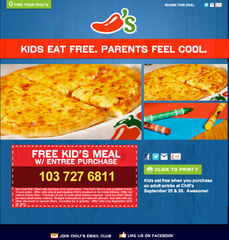 These are landing pages created specifically for your offline campaigns. Keep the URLs very, very short using redirect URLS.Just like your coupon codes, these URLs need to be short and over-the-top easy to remember. Your company can even consider buying a custom domain name. Just make sure to add a no-index meta tag so that Google doesn’t crawl the page for ranking in search.
These are landing pages created specifically for your offline campaigns. Keep the URLs very, very short using redirect URLS.Just like your coupon codes, these URLs need to be short and over-the-top easy to remember. Your company can even consider buying a custom domain name. Just make sure to add a no-index meta tag so that Google doesn’t crawl the page for ranking in search.As with your coupon codes, you can maximize conversion opportunities using iPad kiosks. If iPad kiosks are integrated as part of your museum, store, event, or display, you can make these pages immediately accessible and interactive: again, like a fun game. If people are empowered to take action on your advertising calls to action (CTAs) immediately, you’ll see a boost in user engagement activity.
Tip: When you design your landing pages, make sure that you choose a responsive design. Consider using a platform like Unbounce to make this process incredibly easy.
5. Track Phone Calls
With offline marketing, the most important CTA may be a phone call rather than a visit to your company’s website. You’ll want to see how many calls you’re getting and where they might be coming from. The challenge with monitoring this metric is that there is a huge black box. But, you can still benchmark progress by paying attention to the following:
- Step 1: Calculate how many calls are coming in through online channels. You can use the Goals feature in Google Analytics to see how many people are clicking through to the ‘contact us’ page on your website. If you’re running a mobile SEM campaign with Google’s click-to-call feature as a conversion goal, you can calculate a number there.
- Step 2: Calculate a differential between the total number of calls you’re getting and the ones that you know are coming from your website.
- Step 3: Think about how many calls are coming through indirect channels (i.e., people who visit your website and then call you later). This might be a rough approximation but still – make an educated guess, and stick to it.
- Step 4: Once you’ve gone through the due diligence of steps 1 through 4, start looking at correlations between offline marketing pushes and call volume. By monitoring this general trend, you’ll start to get a feel for which initiatives are working.
iPad kiosks can help you amplify call conversions. If you’re hosting an event, you can ask audiences to follow up with a call – right then and there. You can even create a unique phone number to track calls from that specific event. Having an iPad kiosk will simplify the process of putting consumers in touch with your company.
Keep in mind that your analytic strategy here will be a rough approximation. Don’t fixate on the details. Marketers today are obsessed with precise attribution – which is important, but here’s the thing: It will never be perfect.
Make sure that you’re looking at marketing activity (and ROI) holistically too. This approach will be crucial when you’re measuring CTAs as phone calls to your company.
II. HARNESS THE POWER OF MOBILE
Mobile is the one technology that is changing the world – it is also the technology with the strongest potential to unite online and offline worlds.
It's no surprise, given that the app economy is booming:
- Consumers in the United States spend more than two hours per day on their mobile devices
- The average user has more than 100 apps on their mobile device
- The app economy has created more than half a million jobs
- The app industry is worth $25 billion
A report from the United Nations points out that around the world, more people have mobile phones than access to toilets.
People love engaging with mobile and tablet devices. The experience comes naturally and is wholly integrated into our everyday lives.
Have you ever looked at a toddler using an iPad? These kids can literally pick up a device and be fluent within minutes.
When people are in your store, however, they won’t necessarily think to take out their mobile devices and start tweeting about your brand. What your company can do to bridge this gap is integrate iPad kiosks into your event, store, or organization’s core aesthetic experience.
For instance, you can run your checkout process entirely through an iPad and use this platform to run a short survey or integrate social media (i.e., give people the option to tweet about their awesome experience at your company.
What’s also worth mentioning is that getting a customer to download your swanky app while in-store is impossible unless you incentivize them with discounts on merchandise. Putting your app on an in-store iPad kiosk can educate them on why the app is useful to them and result in them potentially putting the app on their personal devices. Couple this user experience with a coupon for installing, and you’ll get a lot more people to install the app on your device.
Here are some ideas for tactics to try:
1. Social Check-Ins
 Set-up kiosks where people (event goers, customers, class attendees) can login to their social media accounts. You can integrate this process with a basic event check-in – a process that everyone has to go through anyway. You can give people the option to register via their social media accounts.
Set-up kiosks where people (event goers, customers, class attendees) can login to their social media accounts. You can integrate this process with a basic event check-in – a process that everyone has to go through anyway. You can give people the option to register via their social media accounts.You can even offer incentives (freebies, coupons, etc.) for people to do this. Make it fun -- set up a contest or make the process interactive. You could give people a really cool freebie in exchange for them (optionally) tweeting about or or checking into your event via FourSquare or Twitter.
Just make sure to plan this process strategically. Consumers won’t just jump to your iPad kiosk, log-in to Twitter, and start sharing status updates. That’s not a natural user activity. What you need to do is craft the user experience beforehand so that attendees engage with your brand and have fun.
If you’re using Twitter as a check-in or social promotion strategy, make sure to incorporate hashtags to ensure that you’re driving distribution to the right audiences. Use an existing hashtag that is popular, or create a custom one for the specific event.
Keep in mind that any social check-in will need to be an optional feature – not everybody will be excited to advertise that they’re at your event. Be respectful of folks who are more private on social media.
2. Event Photo Booths
 iPad kiosks make great pop-up photo booths! At your next conference or tradeshow, set up a display with several iPad kiosks and props for folks to try on. You can even skip the props and use an app like Picibooth that has built-in graphics. It costs – get this – $1.99. While other budget-strapped marketers are struggling to collect freebies, you’ll have the best event display in the room.
iPad kiosks make great pop-up photo booths! At your next conference or tradeshow, set up a display with several iPad kiosks and props for folks to try on. You can even skip the props and use an app like Picibooth that has built-in graphics. It costs – get this – $1.99. While other budget-strapped marketers are struggling to collect freebies, you’ll have the best event display in the room.There are companies that you can hire that will set up temporary iPad kiosk photo booths for your retail location to help you achieve social check-ins and postings. Sephora does this in their Time Square location. Companies including Pict-E, TheBosco.com and Lensley.com can help you get set up.
3. Retail Applications
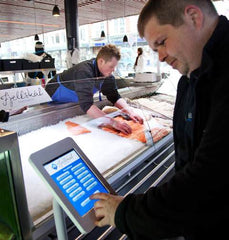 iPad kiosks can help you set up an all-in-one transaction system that lets you process payments and collect customer feedback (yes, in one place). The beauty of these systems is that they’re customizable depending on need. You can use them as a tool for customizing orders, processing transactions, collecting customer data, and promoting social media activity. You can even collect core user data about your customers.
iPad kiosks can help you set up an all-in-one transaction system that lets you process payments and collect customer feedback (yes, in one place). The beauty of these systems is that they’re customizable depending on need. You can use them as a tool for customizing orders, processing transactions, collecting customer data, and promoting social media activity. You can even collect core user data about your customers.Sephora, for instance, is using iPad kiosks in conjunction with a Pantone color scanning camera to identify the skin tones of customers and select the best foundation for them. This interactive sales approach is key to driving the adoption of new products that might otherwise be overlooked and deepening their relationship with new customers. The bonus is the back-end data they are collecting on thousands of store visitors on their skin tones and foundation choices, which in turn will inform their future marketing choices (which demographics to go after, how to address their needs, etc.).
Imagine the ‘big data’ significance of this configuration – Sephora can combine consumer behavior data and spend thresholds to build the ultimate behavioral targeting model. The data can be used to target consumers both online and offline. Pretty cool, huh?
4. QR Codes
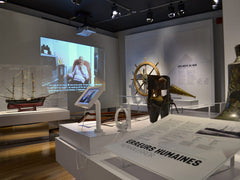 Customer research is as much about the journey as it is about the information.
Customer research is as much about the journey as it is about the information.QR codes can be a great tool for creating a fun and interactive exercise with your audiences – especially if you’re hosting an event display or if you’re part of a museum.
Start by setting up a series of iPad kiosks where users can check in. Even just a few would be enough, depending on the amount of foot traffic that you expect at your event or venue.
Create a handful of QR campaigns that you want to share with your audience. These could be videos, text-driven, or interactive games – stretch your imagination to design a fun and engaging user experience. You can place these QR codes on note cards, badges, or flyers that you hand out to employees. You can even put a huge poster on the wall:
Create a fun game, interactive display, and have audiences pick and choose what they want to see at each kiosk. The kiosks will help add structure to this incredibly fun interactive exercise, as people may not want to use their phones.
III. GET SMART ABOUT IN-STORE DISPLAYS
The days of static advertisements are (almost) over. Anything and everything has the potential to be interactive. Smart business owners are well-aware these opportunities. The problem?
They’re not empowered to actually execute.
In-store multimedia campaigns are expensive to execute. That’s why the world’s biggest brands get all the attention. They have infinite resources to pull PR stunts and execute creative ideas.
But here’s the thing.
Interactive advertisements is far from all or nothing. iPad kiosks present a powerful, happy medium for taking engagement to the next level (without stretching your budget to the next level).
1. Big Data at Events
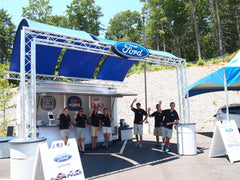 iPad kiosks can make it extremely easy to collect customer data at events and brick-and-mortar storefronts.
iPad kiosks can make it extremely easy to collect customer data at events and brick-and-mortar storefronts.Hyundai and Ford both used Lilitab at roadshows in 2012, 2013 and 2014. By issuing RFID bracelets to attendees and installing an RFID reader on each kiosk the companies were able to understand (at a very granular level) who stopped and spent time with each car model at the events.
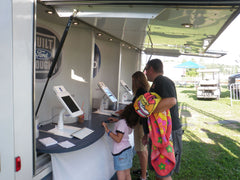 Marketing teams were given access to a wealth of customer data – demographic information, geographic data, and general consumer preferences. RFID tags and iPad kiosks empowered the auto giants with the ability to quickly see which vehicles were most attractive and appealing to customers (and most importantly, why).This approach saves time and money.
Marketing teams were given access to a wealth of customer data – demographic information, geographic data, and general consumer preferences. RFID tags and iPad kiosks empowered the auto giants with the ability to quickly see which vehicles were most attractive and appealing to customers (and most importantly, why).This approach saves time and money.Traditionally, this level of data collection requires focus groups, which are expensive and time consuming. It takes a long time to develop sample surveys and extrapolate group-level trends. Ford and Hyundai’s roadshow empowered the auto giants to collect data from tens of thousands of interactions and visitors.
2. Analytics and Tracking in Smart Displays
Multimedia can add an unparalleled level of engagement to in-person events. Just take a look at some of the world’s top museums (like the Maritime Museum of Quebec that has video testimonials as part of their exhibits).
 These displays have the potential to be more than just entertainment platforms – organizations can collect user data to (1) customize the immediate experience and (2) learn more about its audience.
These displays have the potential to be more than just entertainment platforms – organizations can collect user data to (1) customize the immediate experience and (2) learn more about its audience.Do more than broadcast a message – ask questions to better familiarize yourself with your audience’s core experience.
3. Intelligent In-Store Ads
Redefine your store’s marketing signs. Instead of forcing customers to look at boring banners, set up a few kiosks with interactive displays. These in-store features will spark curiosity and provide a platform for collecting data about your audience.
If you’ve made it all the way through this guide, this last section should be fairly intuitive. One thing is clear – iPad kiosks will help you stretch your imagination. You can customize your ads to be more than just ads.
Make it fun. Make it a game. Make it social. Listen, and learn.
Ads don’t have to feel like ads anymore.
4. Final Thoughts: Be Creative with Your Data
Data is a discipline where art meets science. To be effective (and accurately capture) the results of your online marketing, you need to think on your feet. In the majority of cases, you won’t have access to precise, granular data. iPad kiosks can help bridge this gap but will ultimately be one part of your marketing analytics equation.
We’ll leave you with the following suggestions to make sure that you’re well positioned to track and optimize the results of your offline marketing campaigns:
- Talk to your customers. Quantitative data will tell you what happened, but qualitative insights will tell you why. As you’re collecting information, make sure that you’re optimizing face-time through conversations with your customers.
- Think of social media as a proxy for word-of-mouth data. Social media is an online platform for talking about your brand. Its roots are grounded in consumer psychology. If people are talking about your company online, chances are, they are also talking about you in real life. Social media can be a strong indicator for your company’s word-of-mouth influence.
 Sanity check your data from multiple sources. Because data is an art, your findings may not be precise. Imagine that you’re playing a game of darts. Your strategy and positioning will have the strongest impact in guiding your results. You’re going to be collecting marketing analytics data from a variety of sources. Make sure to cross-compare them to make sure that you’re pursuing the right numbers.
Sanity check your data from multiple sources. Because data is an art, your findings may not be precise. Imagine that you’re playing a game of darts. Your strategy and positioning will have the strongest impact in guiding your results. You’re going to be collecting marketing analytics data from a variety of sources. Make sure to cross-compare them to make sure that you’re pursuing the right numbers.Ultimately, you need to measure the combined efficiency of all marketing channels. The bigger details are just as important as the smaller nuances. As a marketer, you’ll be most empowered when you can effectively balance both.











